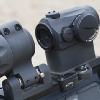TECHNICAL NOTES
AR15 Upper Receiver Weight Comparisons -
The purpose of this review is an attempt to give the reader an apples to apples comparison of different upper receiver weights. As more info or configurations become avalible, I will update this review. All weights were as you see the upper receiver in the picture. None of the upper receivers had bolt carrier groups or charging handles in them when they were weighed. I ensured everything was the same on all uppers weighed.
[more >>] |
Advantages of Mid-Length Carbines for Law Enforcement Officers -
Some overlooked advantages of the Mid-Lenght gas system carbine over the carbine-length gas system AR15 for Law Enforcement Officers: The longer handguard on the Mid-Length aids in resting the barricade on a piece of cover. This is often overlooked by many law enforcement officers. Many times in a law enforcement setting when a carbine is deployed the Patrol Officer will take up a position of cover on a perimeter or while covering a person or location. While taking up a position of cover we often rest our carbine on a piece of cover (vehicle, fence, concrete wall, tree, post, etc.). The piece of cover often times can serve a dual purpose and can be used as a stable shooting platform.
[more >>] |
Carbine vs. Mid-Length Gas System on a 16" Barrel -
When talking about the different gas systems on a 16" barrel, think about the distance from the gas hole to the end of the barrel. The longer that the bullet is in the barrel after the bullet passes the gas hole, the more gas that is getting pushed back through the gas tube and back into the gas key. The end result is a sharper recoil impulse. This is why on a 16" barrel, a mid-length gas system is slightly smoother than a carbine length gas system. Something to note. The 20" barrel with rifle length gas system, 16" barrel with mid-length gas system, and 14.5" barrel with carbine length gas system all have the same amount of dwell time (distance from the gas hole to the end of the barrel).
[more >>] |
Trijicon ACOG Considerations -
Eye relief has much more utility than keeping the scope from hitting your face when the scope is mounted on a rifle that has heavy recoil. Eye relief aids in locating targets quicker (when engaging multiple targets at various distances) and getting on target quicker (because head position and scope shadow are not as critical with longer eye relief). While I find the weight and size of the TA01NSN and the TA31 almost perfect for a fixed 4x optic, my main complaing about the TA01NSN and the TA31 is the short eye relief. Short eye relief is not a big issue if all your shooting will be done from a bench, but the short eye relief on the TA01NSN and TA31 ACOGs really expose themselves when running and gunning and shooting from non traditional positions.
[more >>] |
Do It Yourself Gas Buster Charging Handle -
If you look at this same area from the side, you will notice that there is a space between the charging handle and the upper receiver. This is where a majority of excess lube, gases, and debris escape out of the upper receiver and are directed into the shooters face. By filling the half circle gap on the charging handle with RTV silicone you can make a cheap and very effective "gas buster" for your charging handle, and this prevents lube, gases, and debris from being blown back into your face.
[more >>] |
Getting the 3x Magnifier closer to the Aimpoint Micro T1 -
In February of 2008 I wrote a review on the Aimpoint 3x Magnifier. As
a result of that review some shooters reported having no issues with
the magnifier, while others reported having issues with the magnifier
causing dot distortion, and one or two shooters even reported seeing
two separate dots that were touching and looked like a figure 8.
[more >>] |
AR15 Sound Suppressor Selection -
When selecting a suppressor, point of impact shift, type of mount, weight, and length of the suppressor are my main concerns. Cost and noise reduction are the lowest on my list of concerns. When noise reduction is mentioned, a lot of guys will make a mountain out of a mole hill in reference to a couple decibels.
[more >>] |
Noveske KX3 and Barrel Length Considerations -
From time to time I see new shooters wanting to put a Noveske KX3 on a 14.5" or longer barrel. I would not recommend a KX3 for a barrel over 11.5" (give or take an inch). I ran a KX3 on my 11.5" barrel on my work gun. I liked that the KX3 directed the muzzle blast, flash, gases, and noise down range (toward the target). Short barreled rifles can be obnoxious and when shooting in close proximity to other Officers a Noveske KX3 on a short barreled rifle has utility. Take the following into consideration if considering the Noveske KX3. The KX3 is 8 oz. (1/2 pound) and adds approximately 2.75" to the overall length of the barrel.
[more >>] |
Which Carbine Is More Accurate -
I often see guys on the internet saying my "Brand X" AR15 is more accurate than my "Brand Z" AR15. I doubt that a majority of these guys have done an apples to apples comparison between two rifles in a controlled enviornment. For accuracy or group size to mean anything or for the evaluation to be apples to apples comparison you need to shoot carbines side by side on the same day, one right after the other. Both guns need to be in the exact same configuration, using the same optic, the same ammo from the same lot, a couple different ammo loadings, the same type of targets, the same lighting conditions, etc. All of the things listed above can have an effect on accuracy testing.
[more >>] |
AR15 Buttstock Considerations -
What stock you use on what gun really comes down to personal preference and personal preference differs from person to person and is not something that can be easliy explained or decided over the internet. Something I have learned about AR's over the years is, it's a game of matching the right part with the right gun. You may try a stock on a 10.5" SBR and hate it, and then try the same stock on a 16" mid-length carbine and think it's the best stock on the market.
[more >>] |
Vertical Foregrip Placement -
Running the vertical foregrip all the way forward on a carbine length rail system is not anything new and it's not anything I thought up myself. I had tried moving the vertical foregrip all the way forward several times in the past and it just never "felt right". I never gave the technique much chance and didn't run the vertical foregrip all the way forward over a prolonged period of time.
In late May of 2007, I tried moving the vertical foregrip all the way forward and everything fell into place and the technique finally "clicked". After several years and several attempts I finally figured out why there were so many advantages to having the vertical foregrip all the way forward on a carbine length rail.
[more >>] |
Tactical Slings For The Carbine -
Since early 2006 I have been using an quick adjust 2 point tactical sling. In the slung postion the gun lies diagonally across your body. This makes walking easier, the carbine doesn't hit the shooter when he transitions to pistol. If performing tasks with your hands you can move the gun to your back and it retains well simular to a 3 point sling. The adjustment on the VCAS and VTAC slings are very quick and easy to use and the sling can be adjusted with one hand. This lets the shooter have as much slack in the sling or retention as he needs.
[more >>] |
Why Glock, why 9mm? -
In 2001 I attended a two day tactical pistol course. As a test to myself to see which platform suited me better, I shot the first day of class with a Les Baer Thunder Ranch Special (full size 1911) and the second day of class with a Glock 35 (the Glock 35 is Glock's Pratical / Tactical model and is almost the same size as a full size 1911). It was after this class of shooting 500 rounds per day through each gun, back to back, that I realized that I prefered the Glock platform by a wide margin.
[more >>] |


